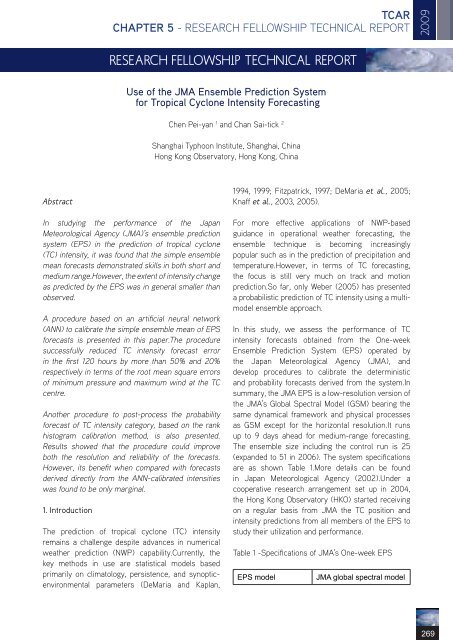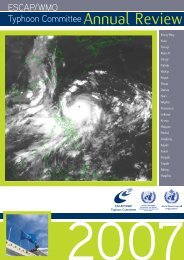TCAR - Typhoon Committee
TCAR - Typhoon Committee
TCAR - Typhoon Committee
You also want an ePaper? Increase the reach of your titles
YUMPU automatically turns print PDFs into web optimized ePapers that Google loves.
Abstract<br />
<strong>TCAR</strong><br />
CHAPTER 5 - RESEARCH FELLOWSHIP TECHNICAL REPORT<br />
RESEARCH FELLOWSHIP TECHNICAL REPORT<br />
In studying the performance of the Japan<br />
Meteorological Agency (JMA)’s ensemble prediction<br />
system (EPS) in the prediction of tropical cyclone<br />
(TC) intensity, it was found that the simple ensemble<br />
mean forecasts demonstrated skills in both short and<br />
medium range.However, the extent of intensity change<br />
as predicted by the EPS was in general smaller than<br />
observed.<br />
A procedure based on an artificial neural network<br />
(ANN) to calibrate the simple ensemble mean of EPS<br />
forecasts is presented in this paper.The procedure<br />
successfully reduced TC intensity forecast error<br />
in the first 120 hours by more than 50% and 20%<br />
respectively in terms of the root mean square errors<br />
of minimum pressure and maximum wind at the TC<br />
centre.<br />
Another procedure to post-process the probability<br />
forecast of TC intensity category, based on the rank<br />
histogram calibration method, is also presented.<br />
Results showed that the procedure could improve<br />
both the resolution and reliability of the forecasts.<br />
However, its benefit when compared with forecasts<br />
derived directly from the ANN-calibrated intensities<br />
was found to be only marginal.<br />
1. Introduction<br />
Use of the JMA Ensemble Prediction System<br />
for Tropical Cyclone Intensity Forecasting<br />
The prediction of tropical cyclone (TC) intensity<br />
remains a challenge despite advances in numerical<br />
weather prediction (NWP) capability.Currently, the<br />
key methods in use are statistical models based<br />
primarily on climatology, persistence, and synopticenvironmental<br />
parameters (DeMaria and Kaplan,<br />
Chen Pei-yan 1 and Chan Sai-tick 2<br />
Shanghai <strong>Typhoon</strong> Institute, Shanghai, China<br />
Hong Kong Observatory, Hong Kong, China<br />
1994, 1999; Fitzpatrick, 1997; DeMaria et al., 2005;<br />
Knaff et al., 2003, 2005).<br />
For more effective applications of NWP-based<br />
guidance in operational weather forecasting, the<br />
ensemble technique is becoming increasingly<br />
popular such as in the prediction of precipitation and<br />
temperature.However, in terms of TC forecasting,<br />
the focus is still very much on track and motion<br />
prediction.So far, only Weber (2005) has presented<br />
a probabilistic prediction of TC intensity using a multimodel<br />
ensemble approach.<br />
In this study, we assess the performance of TC<br />
intensity forecasts obtained from the One-week<br />
Ensemble Prediction System (EPS) operated by<br />
the Japan Meteorological Agency (JMA), and<br />
develop procedures to calibrate the deterministic<br />
and probability forecasts derived from the system.In<br />
summary, the JMA EPS is a low-resolution version of<br />
the JMA’s Global Spectral Model (GSM) bearing the<br />
same dynamical framework and physical processes<br />
as GSM except for the horizontal resolution.It runs<br />
up to 9 days ahead for medium-range forecasting.<br />
The ensemble size including the control run is 25<br />
(expanded to 51 in 2006). The system specifications<br />
are as shown Table 1.More details can be found<br />
in Japan Meteorological Agency (2002).Under a<br />
cooperative research arrangement set up in 2004,<br />
the Hong Kong Observatory (HKO) started receiving<br />
on a regular basis from JMA the TC position and<br />
intensity predictions from all members of the EPS to<br />
study their utilization and performance.<br />
Table 1 -Specifications of JMA’s One-week EPS<br />
EPS model JMA global spectral model<br />
2009<br />
269

















